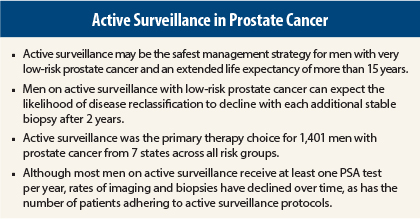Active surveillance has become a viable option for many men with low-risk prostate cancer who choose not to undergo active treatment such as surgery or radiotherapy. Four studies evaluating the effectiveness, trends, and other considerations for active surveillance in managing prostate cancer were presented during the 110th Annual Scientific Meeting of the American Urological Association (AUA).
Long-Term Follow-up for Favorable-Risk Prostate Cancer
Jeffrey Tosoian, MD, and colleagues of Johns Hopkins University School of Medicine in Baltimore found that active surveillance appears to be a safer management strategy for men with “favorable-risk” prostate cancer.1
Favorable-risk patients are defined as patients with a Gleason score ≤ 6 and a prostate-specific antigen (PSA) level ≤ 10 ng/mL. A long-term study evaluated data from 1,298 men diagnosed since 1995 for primary outcomes, including overall survival, cancer-specific survival, and metastasis-free survival.
At 10- and 15-year follow-up, overall survival was 93.2% and 68.7%, cancer-specific survival was 99.9% and 99.9%, and metastasis-free survival was 99.4% and 99.4%, respectively. These data suggest that for men with an extended life expectancy of more than 15 years, active surveillance may be the safest management strategy for men with very low-risk disease.
When Can Patients Stop Worrying?
A new study conducted by Ridwan Alam, MD, and colleagues of Johns Hopkins University School of Medicine suggests that men on active surveillance for low-risk prostate cancer can expect the likelihood of disease reclassification to decline with each additional stable biopsy after 2 years.2
Low-risk prostate cancer can be defined as category T1 or T2a. The subcategory of very low-risk prostate cancer has the most favorable results. These men have clinical stage T1c with a Gleason score ≤ 6. Patients with very low-risk prostate cancer have a PSA density less than 0.15 ng/mL/g. Upon biopsy, these patients have no more than two cores with cancer, and the positive cores have no more than 50% cancer.
Among 808 men identified on active surveillance (557 with very low-risk disease and 251 with low-risk disease), researchers found similar reclassification rates within the first 2 years. After this period, however, men in the low-risk group were twice as likely to be diagnosed with progressing disease (Gleason score > 6) than those in the very low-risk group. For both groups, the risk of lifetime reclassification beyond 2 years decreased by 30% and 35%, respectively, after each nonreclassifying biopsy.
Active Surveillance Rates in Community Urology Practices
Across the country, the adoption of active surveillance as a treatment option for men with low-risk prostate cancer is on the rise, according to new research by Jeremy Shelton, MD, and colleagues of the University of California, Los Angeles; Bethesda North Hospital; Providence Little Company of Mary Medical Center Torrance; and Carolina Urologic Research Center.3
Of the 1,401 men identified in the study as meeting study inclusion criteria, the average age was 63.6 years. Additionally, based on data from community-based urology practices in California, Colorado, Indiana, North Carolina, Ohio, Oregon, and South Carolina, 17.3% had very low-, 36.1% had low-, and 42.7% had intermediate-risk prostate cancer. Across all risk groups, the primary therapy choice was active surveillance (70.2% of men with very low, 39.2% of men with low, and 7.7% of men with intermediate risk of disease progression). Risk level, age, and urology practice predicted the choice of active surveillance, whereas race did not.
Patterns of Care for Men Undergoing Active Surveillance
Despite a global increase in active surveillance as a treatment strategy for men with low-risk prostate cancer, there is no consensus on the protocol to use when following men during surveillance, and practice patterns vary widely, according to a retrospective study by Stacy Loeb, MD, and colleagues of New York University (NYU).4
Reviewing records for 5,192 men from the Surveillance, Epidemiology, and End Results (SEER)-Medicare linked database, researchers found that although most men receive at least one PSA test per year, rates of imaging and biopsies declined over time, as did the number of patients adhering to active surveillance protocols. Younger men and those diagnosed in more recent years had a higher frequency of surveillance biopsies.
“Active surveillance should be encouraged for men with low-risk prostate cancer that can delay or avoid the need for treatment,” said Dr. Loeb, who is Assistant Professor in the Department of Urology, Population Health and Laura & Isaac Perlmutter Cancer Center, New York University, and who moderated a press conference on these studies. “However, the surveillance is meant to be an active process, so men on active surveillance should continue to follow up with their doctor regularly.” ■
Disclosure: Dr. Loeb is on the advisory board of and receives honorarium for lecture from Bayer.
References
1. Tosoian J, Mamawala M, Epstein J, et al: A prospective, longitudinal active surveillance program for favorable-risk prostate cancer. 2015 AUA Annual Scientific Meeting. Abstract PD6-04. Presented May 15, 2015.
2. Alam R, Ballentine Carter H, Landis P, et al: Active surveillance: When can patients stop worrying? 2015 AUA Annual Scientific Meeting. Abstract MP42-04. Presented May 17, 2015.
3. Shelton J, Buffington P, Koo A, Shore, N: Contemporary active surveillance rates for newly diagnosed prostate cancer patients in community urology practices. 2015 AUA Annual Scientific Meeting. Abstract MP4-03. Presented May 15, 2015.
4. Loeb S, Walter D, Dewitt S, et al: Patterns of care for men with prostate cancer undergoing active surveillance as initial management. 2015 AUA Annual Scientific Meeting. Abstract PD34-11. Presented May 18, 2015.






